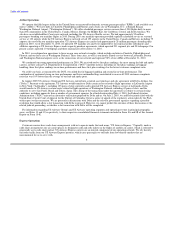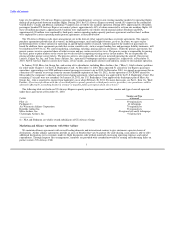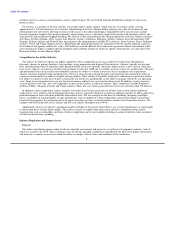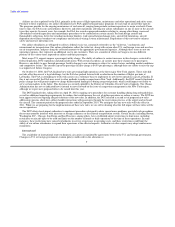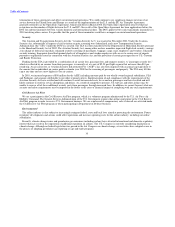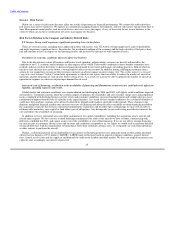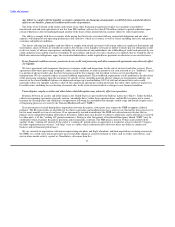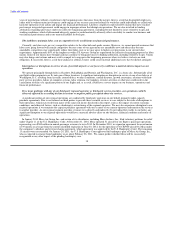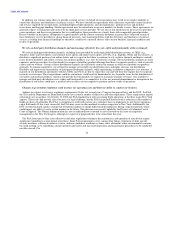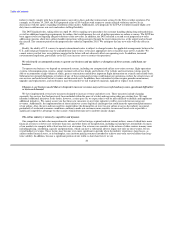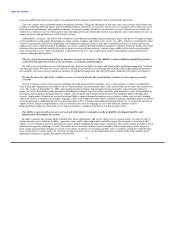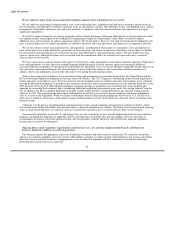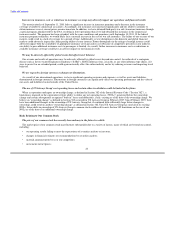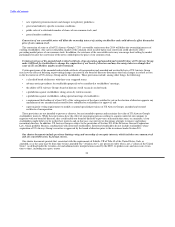US Airways 2010 Annual Report Download - page 17
Download and view the complete annual report
Please find page 17 of the 2010 US Airways annual report below. You can navigate through the pages in the report by either clicking on the pages listed below, or by using the keyword search tool below to find specific information within the annual report.
Table of Contents
any particular period may fluctuate based on LIBOR and other variable interest rates. To the extent these interest rates increase, our
interest expense will increase, in which event we may have difficulties making interest payments and funding our other fixed costs, and
our available cash flow for general corporate requirements may be adversely affected. See also the discussion of interest rate risk in
Part II, Item 7A, "Quantitative and Qualitative Disclosures About Market Risk."
Our business is dependent on the price and availability of aircraft fuel. Continued periods of high volatility in fuel costs, increased
fuel prices and significant disruptions in the supply of aircraft fuel could have a significant negative impact on our operating
results and liquidity.
Our operating results are significantly impacted by changes in the availability, price volatility and cost of aircraft fuel, which
represents one of the largest single cost items in our business. Fuel prices have fluctuated substantially over the past several years and
sharply in the last three years.
Because of the amount of fuel needed to operate our airline, even a relatively small increase in the price of fuel can have a significant
adverse aggregate effect on our costs and liquidity. Due to the competitive nature of the airline industry and unpredictability of the
market, we can offer no assurance that we may be able to increase our fares, impose fuel surcharges or otherwise increase revenues
sufficiently to offset fuel price increases.
Although we are currently able to obtain adequate supplies of aircraft fuel, we cannot predict the future availability, price volatility or
cost of aircraft fuel. Natural disasters, political disruptions or wars involving oil-producing countries, changes in fuel-related
governmental policy, the strength of the U.S. dollar against foreign currencies, speculation in the energy futures markets, changes in
aircraft fuel production capacity, environmental concerns and other unpredictable events may result in fuel supply shortages, additional
fuel price volatility and cost increases in the future.
Historically, we have from time to time entered into hedging arrangements designed to protect against rising fuel costs. Since the third
quarter of 2008, we have not entered into any new transactions to hedge our fuel consumption, and we have not had any fuel hedging
contracts outstanding since the third quarter of 2009. Our ability to hedge in the future may be limited, particularly if our financial
condition provides insufficient liquidity to meet counterparty collateral requirements. Our future fuel hedging arrangements, if any, may
not completely protect us against price increases and may be limited in both volume of fuel and duration. Also, a rapid decline in the
price of fuel could adversely impact our short-term liquidity as our hedge counterparties could require that we post collateral in the form
of cash or letters of credit when the projected future market price of fuel drops below the strike price. See also the discussion in Part II,
Item 7A, "Quantitative and Qualitative Disclosures About Market Risk."
Our high level of fixed obligations limits our ability to fund general corporate requirements and obtain additional financing, limits
our flexibility in responding to competitive developments and increases our vulnerability to adverse economic and industry
conditions.
We have a significant amount of fixed obligations, including debt, aircraft leases and financings, aircraft purchase commitments,
leases and developments of airport and other facilities and other cash obligations. We also have certain guaranteed costs associated with
our regional alliances. Our existing indebtedness is secured by substantially all of our assets.
As a result of the substantial fixed costs associated with these obligations:
• a decrease in revenues results in a disproportionately greater percentage decrease in earnings;
• we may not have sufficient liquidity to fund all of these fixed costs if our revenues decline or costs increase; and
• we may have to use our working capital to fund these fixed costs instead of funding general corporate requirements, including
capital expenditures.
These obligations also impact our ability to obtain additional financing, if needed, and our flexibility in the conduct of our business.
16


